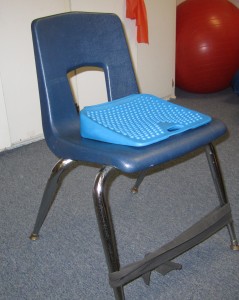Children with special needs very often present with sensory integration difficulties, where their neurological systems are not organizing and responding appropriately to the multitude of sensory information that is entering their system. Intact sensory integration is important for all activities a child does, especially participating and being available for learning in a classroom environment. When a child’s sensory system is dysregulated we may see behaviors such as hyperactivity, poor attention, low arousal/energy, emotional outbursts, or inappropriate social interactions. Many of these children are in classrooms of twenty-five students (or likely more ) with one teacher. How can we support these children in school to better ensure their sensory needs are met in order to be successful students? Working in collaboration with teachers I have found these strategies to be effective and practical in general education settings.
1. Seating

Two traditional sensory strategies that may promote in-seat behavior and attention to task are wrapping heavy resistive Theraband ® around the legs of the student’s desk chair and/or using a wiggle seat (wedge or disc, depends on student’s preference). The Theraband ® allows the child to kick and bump it with their legs, which provides a great amount of proprioceptive input (input to muscles & joints) that help with both body awareness and modulating their arousal level. A wiggle seat allows for movement and can be considered similar to the use of sitting on a therapy ball that research has shown to improve attention by helping to maintain an optimal level of arousal to enable more effective learning. Last, chair or desk push ups are great, especially before writing assignments.
2. Movement in the Classroom
For children that really crave movement, while the above strategies at their desk can help they will likely need more input to regulate their bodies. Functional movement breaks that can help organize a child could include taking a walk to the water fountain or giving the student the opportunity to pass out text books to classmates (movement & heavy work). A teacher I work with told me of a student that needed frequent movement and she made it his daily job to help hand out worksheets to his classmates. This child also presented with fine motor difficulties that made handling the papers difficult, so each morning he was asked to pick a helper to walk around with him and hand him a worksheet that he then placed on each student’s desk. All the children really wanted to be his helper, so not only did this task give this student much needed movement but also encouraged social skills!
3. Snack & Lunch
 The mouth is an organizing center. Think of a crying infant and how sucking on a pacifier or their fingers can be very soothing and self-regulating. Sucking, chewing, and biting resistive food items can be very organizing for sensory kids! First, I encourage teachers to allow children keep a water bottle with a straw at their desks, sometimes a little lemon or mint in the water can help to increase arousal. Parents, when packing your child’s lunch box throw in a wide mouthed straw for them to use to eat their apple sauce or yogurt. Chewy foods like dried fruit, turkey jerky, and bagels provide great oral proprioception. Chewing gum during instructional class time if the school allows can be very effective too. Crunchy foods like carrots, apples, large croutons…think of items that the child really has to really bite and chew and that won’t easily dissolve in their mouth. The crunchier the more sensory input!
The mouth is an organizing center. Think of a crying infant and how sucking on a pacifier or their fingers can be very soothing and self-regulating. Sucking, chewing, and biting resistive food items can be very organizing for sensory kids! First, I encourage teachers to allow children keep a water bottle with a straw at their desks, sometimes a little lemon or mint in the water can help to increase arousal. Parents, when packing your child’s lunch box throw in a wide mouthed straw for them to use to eat their apple sauce or yogurt. Chewy foods like dried fruit, turkey jerky, and bagels provide great oral proprioception. Chewing gum during instructional class time if the school allows can be very effective too. Crunchy foods like carrots, apples, large croutons…think of items that the child really has to really bite and chew and that won’t easily dissolve in their mouth. The crunchier the more sensory input!
4. Recess Time
 Sometimes our kiddos with sensory challenges that can not self-regulate present with perceived negative behaviors in the classroom and often face consequences. Please, please take note that taking away recess should never be a consequence for these children. These are the children that NEED movement breaks to perform better in class. During recess, encourage these students to engage in climbing activities, the monkey bars, and the swings to satiate their individual sensory needs.
Sometimes our kiddos with sensory challenges that can not self-regulate present with perceived negative behaviors in the classroom and often face consequences. Please, please take note that taking away recess should never be a consequence for these children. These are the children that NEED movement breaks to perform better in class. During recess, encourage these students to engage in climbing activities, the monkey bars, and the swings to satiate their individual sensory needs.
5. Hands On
Some students do really well when when they have an opportunity to touch something and keep their hands busy. I love the idea of felt or Velcro ® strips adhered to the inside of a students desk and they can touch this throughout a lesson and it is not distracting to others. In theory, fidget toys are great but can often be quite distracting to the student using it and to his classmates around him. My advice, experiment with a fidget toy but be prepared it may not work for the reasons I just mentioned. Having a small bottle of lotion (maybe lavender scented which is a soothing scent) in their back pack or desk can also be used at times. This is especially useful for those sensory seeking students that often touch everything and at times others around them.
Parents, how can you ensure that these strategies are in place for your child?
- Communication with your child’s teacher is key. Ask questions!!!
- If your child receives occupational therapy outside of school I would strongly suggest the school team and your outside OT collaborate to discuss your child’s sensory needs.
- On an Individualized Education Plan (IEP) sensory strategies that are effective for your child can be incorporated under Accommodations & Modifications to legally ensure they are implemented by the school staff (i.e. use of a wiggle seat, movement breaks, chewing gum, etc).
What sensory strategies help your child or students get through their school day? Share your ideas below!
– Sari Ockner, OTR/L
Please refer to these two studies that support the use of wiggle seats and therapy balls to help with increased attention in the classroom. 1. Seating That Makes ‘Sense’: A Sensory-Based Classroom Technique 2. Classroom Seating for Children With Attention Deficit Hyperactivity Disorder: Therapy Balls Versus ChairsShop for sensory items at Sensible Sensory Solutions – Solutions for School
Like Kidz Occupational Therapy on Facebook Follow on Twitter @Sari_KidzOT



Leave a Reply